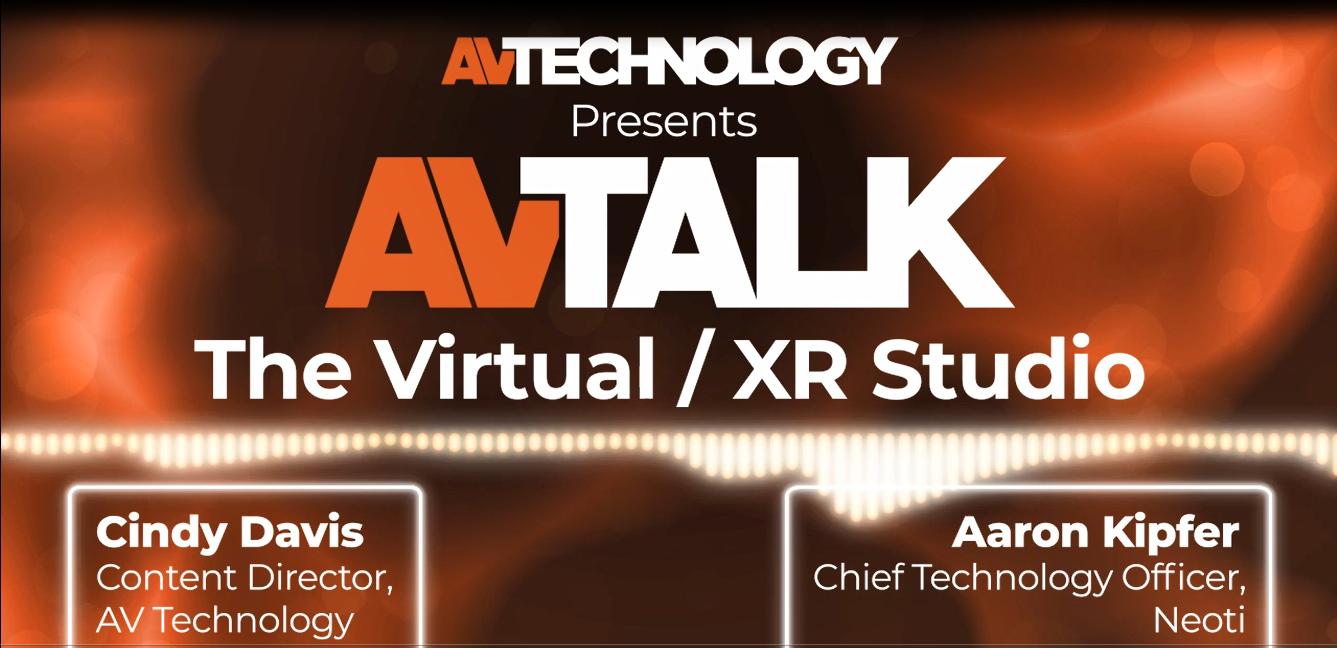
Sponsored content from Neoti
Once only used in productions such as the Star Wars franchise series, The Mandalorian, XR studios, also called virtual studios can now be found in the corporate office, higher education, houses of worship, and many other applications. AV Technology sat down with Neoti’s chief technology officer, Aaron Kipfer to learn more about the LED walls and other elements that comprise the virtual studio.
AV Technology: Neoti is very well known in the broadcast industries, but some of our pro AV audience might not be quite as aware of your brand. So if you wouldn't mind giving us a little bit of an overview, that'd be great.
Aaron Kipfer: Neoti's been around since 2006, and we really dove deep into LED in 2014-15. We felt we had to prove ourselves as a new manufacturer, which is why we started with high-quality, mission-critical displays in the broadcast space. Now we're starting to develop more products outside of the space to target commercial, retail, education, et cetera.
AVT: Tell me about what a virtual studio is.
AK: Really all it means is that what used to be a green screen is now being replaced with LED technology. With LED walls, you can produce backdrops that can change with the environment and provide lighting and other effects that will enhance any kind of video production.
AVT: Are the terms virtual studio and XR studio interchangeable?
AK: XR and virtual studios are basically the same type of thing. XR just means it is mixed media, so it could have some real elements, but most of it is virtually created.
AVT: What are some of the applications that the pro AV audience might see themselves developing?
AK: Once we get into the commercial space, the education sector, or other areas outside of broadcast—all these companies are starting to get into online video creation or Zoom calls. People want to create spaces that aren't just simple green screen features; they're filling office spaces and conference rooms with one- or three-sided LED walls as backdrops—sometimes even including floors and ceilings.
AVT: Let's just take a corporate office, for instance—what elements are needed?
AK: In the simplest of forms, you have the LED wall, the controller, and your cameras that are shooting the talent. But driving the LED wall is the most important part because you have to have some sort of content on it. Often, the engines come from the video game industry, and now people are producing that same type of immersive content and projecting it onto LED walls.
AVT: Are there different pixel pitches that you would consider for different applications—or do all virtual studios use the same pixel pitch?
AK: No, it could be a wide range of pixel pitches. The most important thing with pixel pitch isn't necessarily for it to be as small as possible. You're also considering cost, the size of the space, how far your cameras are from the LED screen, and what you are focusing on. Those factors will determine how tight your pixel pitch needs to be in order to make a good-quality final piece.
AVT: It sounds like it's room size versus application—is that correct?
AK: It's room size, distance to camera, distance to talent—a lot of factors. Broadcast television or news stations are usually at 1.5mm or 1.2mm pixel pitch LEDs because they're a lot closer, and the talent is right in front of a display. We’ve seen some studio spaces, on the other hand, go as high as 3mm to 5mm because the LED walls were so far back.
AVT: What are the key elements are you looking at for an LED wall?
AK: For us, the biggest challenge that we’ve overcome is the ability to produce color-perfect reproduction at low brightness because, as you can imagine, there's not a lot of extra lighting in most of these spaces. The components that you choose for an LED wall have to work together in the best way possible for you to get the best image.
AVT: What components does Neoti provide for the virtual studio?
AK: As a manufacturer, we're focused on the LED itself—making that the best possible product that it can be. Beyond that, we'll provide the control system as part of the package.
AVT: Mounting LED panels can be tricky, is there a recommendation?
AK: We do consult on the mounting; it depends on the product and on the installation. Depending on what the customer needs or wants aesthetically, we will work with some of the big-name mounting manufacturers to produce custom mounts.
AVT: What resources would you suggest for integrators or end users who want to learn more about the virtual studio?
AK: We’ve been producing materials for our website, neoti.com, and through our social channels. But the internet is your friend when it comes to learning more about this because you can talk to so many different people. They'll all have different answers on what virtual studios and XR studio spaces are, but everybody agrees on the basics.
Check out the audio version below.
Want to learn more? Download Why XR is Right For Broadcasters.
About Neoti
Founded in 2006, Neoti is an industry leader in video display technology offering a wide range of dvLED video products designed to provide solutions to many vertical markets and in all environments. We‘ve built on our strength in the mission-critical broadcast market to serve verticals like corporate, sports, education, command centers, healthcare, hospitality and more. Building strong relationships by living out Our Values – Total Commitment, World-Class Support, People First and Partner with Purpose – is foundational to how Neoti does business.



!["[T]he First and Fifth Amendments Require ICE to Provide Information About the Whereabouts of a Detained Person"](https://images.inkl.com/s3/publisher/cover/212/reason-cover.png?w=600)



